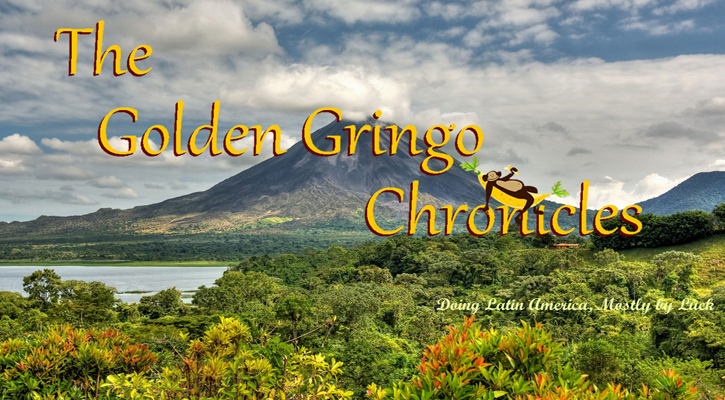

Edition 106 - June 2017
Published at Quepos, Province of Puntarenas, Costa Rica
Publisher: GGC Publications
Editor: Bob Normand, The Golden Gringo, aka "GG"
(©Copyright 2008-2017 All Rights Reserved)
"The mission and goal of the Golden Gringo Chronicles is to provide,
in an
informative and entertaining way, insight into
living
the
Costa Rican
experience as an expat."
Broken News: Gray Hairs on the March, Animal Cruelty Law, Move Over Perrier, Exchange Rate Moving, Platina Now Open
Rumble Talk: Few Rumbles but Rincon de la Vieja Gets Active and the Rainy Season Starts Early and Strong
Que Es Eso? Department: Is it a drone?
Feature: History of Colombia - Part 3, The Modern Era
Feature: Capturing Our Heritage (Quepos' Zona Americana)
Health Stuff: Reader Comments on Yellow Fever Article, YF Vacine in U.S. Running Out
What's-in-a-Word: (Answer to Que Es Eso)
ROMEO Corner (The Free Crab - Quepos)
Wisdom of the Ages
1. I am in shape. Round's a shape. 3. Have you ever noticed? Anybody going slower than you is an idiot, and anyone going faster than you is a maniac. 4. You have to stay in shape. My grandmother started walking five miles a day when she was 60. She is 97 today and we have no idea where she is. Hugh Cowan |
 |
RECENTLY RELEASED! Mariposa, A Love Story of Costa Rica RECENTLY RELEASED!
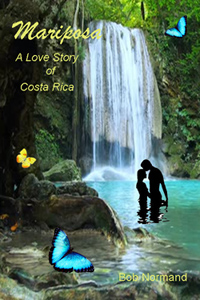 Five hundred years before the Spanish found the American
continent, around the end of the first millennium, Native Americans lived and prospered in Central America, including the land now known as Costa Rica. Truly a natural wonderland then and now, the natives were able to employ their farming skills and prosper from the rich soils, the forests filled with game, herbs, and spices, and the lakes and two oceans rich with fish and crustaceans.
Five hundred years before the Spanish found the American
continent, around the end of the first millennium, Native Americans lived and prospered in Central America, including the land now known as Costa Rica. Truly a natural wonderland then and now, the natives were able to employ their farming skills and prosper from the rich soils, the forests filled with game, herbs, and spices, and the lakes and two oceans rich with fish and crustaceans.
Mariposa, or butterfly, is a story about two young Native Americans, each a favored child of a chief, but of different tribes. These two tribes, historically hostile to each other, lived a few days march apart in the mountains north and east of Costa Rica’s central valley.
The two natives meet by accident, fall in love and begin to plan a life together only to be frustrated by events beyond their control. The lovers are eventually drawn to a mountain volcano which is thought by many to be the home of the gods, particularly Sib'ö, the Great Spirit, who they believe had created the world.
 The story as written incorporates the classic ending of Costa Rica's Legend of Zurqui, one that reflects the beauty, mystery and spirituality that is Costa Rica. Mariposa is available in both English and Spanish versions.
The story as written incorporates the classic ending of Costa Rica's Legend of Zurqui, one that reflects the beauty, mystery and spirituality that is Costa Rica. Mariposa is available in both English and Spanish versions.
Preview the Book (English) on Amazon.com at: Mariposa Preview (This is Chapter 1 in its entirety):
Gray Hairs on the March
 |
 |
| Grandparents Take On Riot Police in Caracas |
Venezuela has been wracked with almost daily demonstrations over the last two months as the economic crisis there worsens. Excessive inflation (see Inflation), severe shortages of medical supplies and food and an unpopular ruling by the supreme court that gutted the powers of the legislature in favor of the president have all contributed to a growing unrest.
On May 12 the demonstration in Caracas involved older people, the March of the Grandparents, holding signs that read "I'm here to defend my grandchildren, to defend my country" and "Respect the elderly". The police would do the latter only to a point and when the gray hairs pushed against the plastic shields of the riot police they were met with pepper spray.
The very old and the very young reportedly have suffered the most during the crisis because of lack of medicines and medical equipment. When the lady that headed the health ministry reported a sharp rise in infant mortality rates over the last two years she was fired for releasing the information.
As of May 23, the death toll during demonstrations of the previous seven weeks totaled just under 50 with hundreds more being injured.
Animal Cruelty Law
Legislating federal law in Costa Rica is a bit different than in the U.S. The legislature here, called the Assemblea, is a unicameral proposition consisted of 56 elected representatives (Diputados). Whereas in the States a bill passes through the House and Senate and then is signed by the President, making it law, in Costa Rica a bill is passed through the Assemblea once, published for a time in the official Public Gazette, then re-debated and passed through the Assemblea a second time, then finally signed by the President into law.
 |
| Cock Fighting (Dog Fighting Also is Popular in Some Locals) |
Last month a new law was passed (46 to 0) for the first time called Ley de Bienestar de los Animales (Law of Wellbeing of Animals). This new law imposes stiff penalties and fines for a variety of offenses related to animals.
The bill would establish a punishment of from 3 months to 2 years in prison for killing an animal intentionally; from 3 months to 1 year in prison for injuring an animal "such that it loses its senses, an organ, a limb, causes severe suffering and agony and permanent damage to health". The law also forbids organizing animal fights, having sex with animals (yccch) and vivisection or performing operations on live animals for the purpose of experimentation or scientific research. These would all receive 3 months to 1 year.
Fines of ¢106,000 and ¢212,000 (about $188-375) would also be imposed on those who do not collect animal feces from public roads (Yes! Send the Policia Fecal to Quepos to enforce this please!), those who do not provide sanitary living conditions for their animals, those that promote animal fights (different from running them), and increase the aggressiveness of the animal (?).
Cock fights and other animal fighting has been banned in Costa Rica for some time (but reportedly still operating in rural areas). Hunting of any animals for any purpose has been banned since 2012.
Move Over Perrier
We have a new entrepreneur in Costa Rica, a fellow named Roy Vargas.
 Señor Vargas (photo left) has been bottling water for over ten years. He started by bottling for major water companies but now he's created his own company and brand, Water Monterreal, and is already marketing internationally; some 3,000 cases recently went to the U.S. market and now he's targeting those bottled-water lovers in Europe. The source of his water is his own property near Ciudad Quesada in the central mountains of Alejuela Province about 60 kilometers northwest of San José as the crow flies (I suspect it's considerably more as the ATV rolls).
Señor Vargas (photo left) has been bottling water for over ten years. He started by bottling for major water companies but now he's created his own company and brand, Water Monterreal, and is already marketing internationally; some 3,000 cases recently went to the U.S. market and now he's targeting those bottled-water lovers in Europe. The source of his water is his own property near Ciudad Quesada in the central mountains of Alejuela Province about 60 kilometers northwest of San José as the crow flies (I suspect it's considerably more as the ATV rolls).
Vargas has 300 hectares/750 acres containing his mountain springs and bottling plant (500 square meters or 5,300 square feet). From this modest facility he believes he has the capacity to bottle up to 70,000 liters of water per day in .24L, .6L and .9L (4 oz, 10 oz , 15 oz) sizes. About the quality of his water, vargas states: “Our water sources are pristine and have a perfect combination of elements such as silicon, calcium, iron, sulfur and magnesium, which deliver us from the need of a purification process.” To back up this claim he points to winning a terrealfirst place award at the International Tasting of Thermal Waters competition.
GG must admit to first having self-quibbled over the name of his new company, Monterreal. It's kind of a latin play on "Monte" (or mountain) and Real = real, or even royal. But the first time I read it I read "Montreal" and wondered what vargas had to do with that Canadian city. You gotta get those new post-cataract-surgery lenses adjusted, GG.
Best of luck and success Señor Vargas! And move over Perrier, Monterreal is coming.
Exchange Rate Moving
 In the past two months there has been significant movement in the U.S. Dollar/Costa Rica Colon exchange rate. In 2008, when I moved here, selling a dollar would yield about 480 colones. the posting on May 24 was 582 and shortly therafter a couple of banks were reporting slightly over 600. That's more than a 25% gain in eight years and is a srong reason why landlords here prefer their rent in dollars when they can get them.
In the past two months there has been significant movement in the U.S. Dollar/Costa Rica Colon exchange rate. In 2008, when I moved here, selling a dollar would yield about 480 colones. the posting on May 24 was 582 and shortly therafter a couple of banks were reporting slightly over 600. That's more than a 25% gain in eight years and is a srong reason why landlords here prefer their rent in dollars when they can get them.
And check out the 60-day movement chart to the left. For several years the rate hovered around 500 making for a comfort factor as well as easier mental conversions (1,000 colones = $2, etc.). Since January 1 of this year the rise has been close to 10%.
As I import dollars to live here (my social security is directly deposited here in dollars), you would think I'd be happy about the raise I just got. But unstable currency always leads eventually to problems and how much of this movement is related the country's fiscal problems (the national budget is operating on nearly a 50% deficit and bond ratings are beginning to show it). Higher exchange rates will likely increase inflation, particularly in many dollar based products and services and imported goods.
Last minute update: Towards the end of the month the colone exchange rate retreated somewhat to 582 on May 30, about 20 colones less than the peak in mid-May.
Platina Now Open
 |
| Newly Opened Platina Bridge |
The major route between downtown San José and its biggest international airport, Juan Santamaria, is an expressway called the General Cañas. The Cañas also serves as a major commuter route between the center and communities west of the city such as Heredia and Alejuela. There are several bridges along this route and one of the most important ones is the Alfredo González Flores Bridge, better and more affectionately known as the Platina.
In 2009, inspectors first noticed that the expansion joints on the bridge were separating well beyond tolerances. For the next seven years various attempts at fixing the problem didn't solve it completely and some months ago it was finally decided that the entire road bed including supports needed to be redone. Virtual havoc occurred during the construction period when periodic total shutdowns and reductions to two and one lane operations backed up cars for miles in both directions.
Finally, on May 24, the new six lane bridge was opened to many cheers. Some reports put the traffic along this route at around a half million cars per day. Press reports also pointed out that there are still two bridges on the route that are four lanes whereas much of the road has now been expanded to six lanes.
Such is life in the big city.
¡Pura Vida!
Rincón de la Vieja
 This month it wasn't Poas or Turrialba, they continued to simmer, but farther up the central mountain chain at a place called Rincón de la Vieja (translates to "The Old Women's Corner") that got more active. It's located about 25 km (15 miles) northeast of the town of Liberia, as the ash flies, in the province of Guanacaste (see map) and not very far from Nicaragua.
This month it wasn't Poas or Turrialba, they continued to simmer, but farther up the central mountain chain at a place called Rincón de la Vieja (translates to "The Old Women's Corner") that got more active. It's located about 25 km (15 miles) northeast of the town of Liberia, as the ash flies, in the province of Guanacaste (see map) and not very far from Nicaragua.
On or about May 23 a forty minute event occurred with nearby residents reporting a roar that sounded like a jet engine followed by some smoking materials running down about a kilometer from the crater rim. Nothing more of significance to date to report.
Let the Rains Begin
 Typically the month of May here begins sunny and ever so gradually the rainfall accelerates throughout the month in the afternoons and evenings. This year the rains began in early May and have increased faster in both frequency and strength. By the end of the month the rains became a daily activity in most of the afternoon and evenings and we even had two or three days where rain occurred throughout the day, not a common experience here.
Typically the month of May here begins sunny and ever so gradually the rainfall accelerates throughout the month in the afternoons and evenings. This year the rains began in early May and have increased faster in both frequency and strength. By the end of the month the rains became a daily activity in most of the afternoon and evenings and we even had two or three days where rain occurred throughout the day, not a common experience here.
In mid-May the rains hit particularly hard in the Central Valley including San José. In addition to disrupting commerce, there was a good deal of localized flooding around the capital as evidenced by the photo to the right.
Let the rains begin (they're great for napping to).
Check Out Recent Earthquakes Around the World Posted by the U.S. Geodetic Survey: Today's Quakes |
¡Solo Bueno!
Search the Golden Gringo Chronicles Archives for Topics That Interest You
You can use our Archives to search for anything that has been written in more than 220 feature articles of the Golden Gringo Chronicles plus find Broken News items and ROMEO restaurant reviews. Enter your topic or item to search in the Google Search Routine below and follow the links offered from the search results. Suggestion: Enter only a simple, precise and unique as possible keyword or two in order to narrow the number of references retrieved:
Readers: Our publication is open to suggestions regarding future articles and will accept pieces written by others but we reserve the right to decline anything that the editorial staff (that's GG) thinks is inappropriate for this format. Send proposals, comments, suggestions, ideas, meaningless statements and jocular observations concerning the Chronicles to GG here: gg@goldengringo.com.

So it was a slow night at the Futsal (indoor futbol arena) and I noticed the two girls in the photo left sitting on the bleachers.
Then above them I noticed something whirring and hovering, phantom-like (the black circle).
It wasn't there the last time I went to the futsal. What could it be, a drone perhaps? Is it a threat to the girls (will I have to come to the rescue?
Answer in What's-in-a-Word section below.
This is the third part of a four part series about Colombia and Cartagena. To read the earlier parts go here: History of Colombia-Part 1, Pre-Columbian Period, & History of Colombia-Part 2, - Spanish Occupation.
This series was originally planned to be three parts as a prelude to a trip planned for Cartagena, Columbia but complications have delayed the trip until September. The article here will complete the three parts devoted to the history of Colombia while the fourth article in this series will cover the actual trip experience later on, after we return.
 |
| Bolivar |
As mentioned in Part 2, Señor Simón Bolivar turned the American Spanish world upside down in the early 1800's while the Spanish monarchy was engrossed in a war in Europe against Napoleon. Bolivar rallied the "criollos" (the American born Spanish nobility) like himself in Venezuela and neighboring countries which had been previously designated by the Spanish crown as the Vice-Royalty of New Granada and convinced them to rebel against the crown.
Inspired by the "enlightenment" movement of the time in Europe and elsewhere and by the success of the North American independence movement that resulted in the United States, and despite a couple of attempts by the crown to squash the rebellion, Bolivar & company succeeded in getting independence for the countries of New Granada in 1821. Venezuela, Colombia, Panama and Ecuador were now free and independent countries and needed to decide how they would govern themselves.
 |
| Gran Columbia |
 |
| Map of Gran Colombia |
About two years before actual achievement of independence (1819), the name and territory called Gran Colombia was used to define a somewhat expanded New Granada. This intended confederation of territories included not only Venezuela, Colombia, Panama and Ecuador but parts of northern Peru, western Guyana and northwest Brazil as well as the Caribbean coast of Nicaragua (the "Mosquito Coast").
Bolivar had been elected as President of Gran Columbia in 1819 and would rule over the territories listed above as well as Bolivia, which was named after him. At the height of his power Bolivar presided as president over a land mass ranging from the border of Argentina all the way north to the Nicaraguan coast. Thousands of commemorative statues and sites are name after him throughout Latin American countries.
After the war ended in 1821 different factions emerged on how to govern the new country. Much like the U.S., the discussion and argument was between those who favored centralized government with a strong president and those that sought a federalist style of government. In 1821 a congress was called and met in San José de Cúcuta, then a small town in Colombia near the Venezuelan border, where a constitution, thereafter called the Constitution of Cúcuta, was drafted.
Bolivar reputedly died of galloping consumption (tuberculosis) but some modern investigators believe it was more likely to have been from an unintended overdose of arsenic received from polluted waters that he imbibed during his time in Peru. More is likely to be revealed on this mystery as more DNA and other testing are underway on his corpse.
 |
 |
| Great Seal and Flag of the Republic of Colombia ("Liberty and Order") |
Like in the formation of the United States, stable self-governing would require time. In the U.S. the Revolutionary War took up over seven years ending in 1783 and another five years were required to form a government, ratify the U.S. Constitution in 1787 and then elect George Washington as the first president in 1788. In Gran Colombia, Bolivar had been elected as president in 1819 and would serve as such until 1830 but pro-constitution factions (including Bolivar) and those that would break-up Gran Columbia into separate nations continued to vie against for more than 50 years after bolivar's death creating periodic instability.
Gran Colombia would slowly break up devolving into the Republic of New Granada (1831-1858), then the Granadine Confederation (1858-1863) followed by the United States of Colombia (1863-1886) and finally the Republic of Colombia in 1886, which has been the remaining country's official name and form of government ever since. The other members of Gran Colombia would become separate republics.
 The history of Colombia since the formation of the republic in 1886 has not been free of problems. The major event history box at the left shows that Colombia has suffered various kinds of conflict including several internal insurrections.
The history of Colombia since the formation of the republic in 1886 has not been free of problems. The major event history box at the left shows that Colombia has suffered various kinds of conflict including several internal insurrections.
During Bolivar's time two parties evolved, the Conservatives under Bolivar and the Liberals under Bolivar's Vice-President, Francisco de Paula Santander and these essentially survived as competitive movements to this day. Communism later also took hold in Colombia as a competing entity.
 |
| Conservative Soldiers at Battle of Palonegro |
The first serious challenge to the government came with the conflict known as La Guerra De Los Mil Días (Thousand Days' War) which began in 1899. Ostensibly this was about coffee but actually it was about economic factors and the struggle for power. The liberals, mostly coffee plantation owners, had been excluded from the government for over 15 years, the ruling class being the conservatives. A severe drop in the market price of coffee not only badly effected the liberals economically but dropped customs revenues going to the conservative government who responded by issuing unbacked currency which, in turn, greatly devalued the peso (current exchange rate = 2,927 pesos per U.S.dollar).
 |
 |
| Panama Canal at Opening and Today |
War ensued and, although the liberals were defeated at the battle of Palonegro in mid-1900, guerrilla actions continued into 1902 until an amnesty arrangement was agreed upon, ending the war. Shortly after the war, when Colombia had been weakened politically, and with United States backing, Panama separated from Colombia, primarily to allow and encourage the canal to be built as the Colombian government had opposed it.
The U.S. then took over the Panama Canal project which had only been partially finished by the French whose company had begun the project in 1881 but who had suffered major problems, not the least of which were losses due to malaria and yellow fever. It is estimated that the French lost 22,000 laborers and the Americans another 5,600 during the construction of the canal, many of them Jamaican immigrants. The French company went bankrupt in 1899. It would take the U.S. until 1913 to complete the canal and commercial shipping began in 1914.
In 1932, the Republic of Colombia found itself in a border dispute with the Republic of Peru. The area in question was the very southern tip of Colombia in the Amazon department and along the Amazon River near the town of Liticia. Both countries claimed sovereignty over the area but it had been considered a part of Colombia for a long time. When Peru began to prevent shipping from reaching Liticia, a strong national reaction occurred in Colombia and the conservative government sent military expeditions to the area. The conflict lasted only about eight months and was eventually resolved by the League of Nations.
The next event to hit the country was World War II. Although not directly involved as a combatant in the conflict, the war had severe repercussions on the country. Colombia, like most Latin American countries, cut diplomatic relations with the Axis Powers in December 1941 just after Pearl Harbor but Colombia refrained from declaring war on them until 1943, until after a series of U-boat attacks on their own shipping (see similar story about Costa Rica during that period here). The Germans ended up sinking several Columbian ships and four smaller sailing craft during the war. The Colombian navy was not large nor powerful enough to prevent the losses or confront the U-boats.
 |
| Gaitán Murder Scene |
The next major event in Colombian history occurred only three years after WW II ended, in 1948, when a period began which was known as "La Violencia". A popular liberal politician, Jorge Eliécer Gaitán, was murdered which set off rioting in Bogotá that killed some 5,000 people. The war was on, hot and heavy, after that. This was essentially a resurgence of the civil war conflict between the conservatives and the liberals that had produced the thousand days war some fifty years earlier. But this time the violence would run ten years, kill an estimated 200,000 people and displace more than a million people from their land.
The war was fought mainly in "el campo", the countryside between paramilitary groups and guerrillas, with conservative campesinos (farmers) fighting against liberal campesinos and both of them causing much of the killing and damage. These armed groups were called "bandeleros". Both liberals and conservatives also fought against communist guerrillas. Because of the conflict, no liberals took office in the 1950 elections. Atrocities were committed on both sides and torture was commonplace.
The reason for the strong name given to the period, La Violencia, was best described by a U.S. national security officer at the time: "Ingenious forms of quartering and beheading were invented and given such names as the 'corte de mica', 'corte de corbata' (aka Colombian necktie), and so on. Crucifixions and hangings were commonplace, political 'prisoners' were thrown from airplanes in flight, infants were bayoneted, schoolgirls, some as young as eight years old, were raped en masse, unborn infants were removed by crude Caesarian section and replaced by roosters, ears were cut off, scalps removed, and so on." Obviously, not a proud moment in Colombian history. Law and order had broken down completely and chaos reigned (shades of Venezuela today).
In 1953, General Gustavo Rojas Pinilla took power and declared an amnesty which was honored by most of the militant groups on both sides and most of the bandeleros disbanded. Some did not, however, and had to be liquidated by the general's troops. Also, during that period, one of the liberal leaders (Pedro Antonio Marín Marín, aka as Manuel Marulanda Vélez " and nicknamed "Tirofijo" or "Sure-shot"), had converted to the communist cause. He would lead them in rebellion against government forces until his death from a heart attack in 2008.
 |
| Signing the National Front Agreement |
Rojas was succeeded by what came to be known as the National Front which lasted from 1958 to 1974, an agreement between the Liberals and the Conservatives to rotate power (so much for general elections - Ed.), alternating the presidency for a period of four terms. Alberto Lleras Camargo, a liberal, was elected the first president of the National Front.
During this period, half of the positions in the federal and municipal governments were allocated to each side, very democratic but hardly representative of the people. Third party candidates were also effectively shut out but splinter groups still existed and eventually gained political strength winning a growing number of seats from both the liberal and conservative sides. In doing that they became a threat to the National Front movement as they garnered an ever increasing number of seats in the assembly.
Guerrilla movements continued also, especially during the second half of the National Front period and the years immediately following it, many being empathetic or even devoted to Marxist-Leninist communist principles. As the National Front dissolved in 1964, several guerrilla movements were born including the Communist leaning: Revolutionary Armed Forces of Colombia (FARC) in 1964, the National Liberation Army (ELN) in 1965, and the Popular Liberation Army (EPL) on July 1967. Others would follow in the 1980's.
 |
| FARC Guerrillas |
FARC would continue to be a thorn in the national government's side well into the 2000's. Financed by both Russia and the drug business, they were well situated to complicate both the workings of the national government and the Colombian-U. S. relationship. FARC got into the "coca boom" in the 1980's, even though they had previously disavowed participation in drugs for years. That made them the enemy of both the central government and the U.S.
A change of government started a new round of negotiations with FARC in 2014. an agreement for amnesty and disarmament was reached in 2016 but rejected by Colombian voters to the tune of 55,000 votes in September of that year. A new agreement with revisions was drawn up and approved in late 2016 followed by the signing of the agreement between the central government and FARC principals. By March of 2017, disarmament had already begun.
Let's hope this time peace is permanent but given the history of Colombia, nothing is for certain.
GG notes that this piece is a bit longer than the typical Chronicles article. I thought it was very important to depict the history of Colombia in all its color in order to understand its history better. This completes our series on the history of Colombia but one more article on Colombia will be forthcoming after our visit to Cartegena in September.
¡Solo Bueno!
An important part of the history of Costa Rica, particularly in the Quepos area, is the era when banana plantations were the dominant employer on the Pacific and Caribbean coasts.
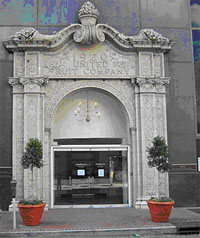 |
| Original United Fruit Facade (1920) in New Orleans |
It all started in the late 1800's when a railroad was constructed from Alejuela to Limón by coffee interests to carry coffee from the central valley to the Caribbean coast for export. The construction company building the railroad was looking for ways to augment their food supplies along a mountainous and tortuous route and hit upon the idea of growing patches of bananas at intervals along the tracks. The story of how the banana industry was born and grew is intertwined with the history of the coffee industry and makes interesting reading on its own. You can read it here.
United Fruit (today known as Chiquita Brands) was born in the early 1900's with the beginning of the banana industry in Costa Rica and originally was based in the Limón area. In 1934, United Fruit (who came to be known locally as the La Compania de la Bananeras) bought out the operations of a banana grower in Quepos, Pirrís Farm Trading Co. UF quickly realized that, given their growth plan, much more would be needed to support their employees needs in the way of stores, a hospital and other services.
 |
| Modern Quepos |
Quepos, as the town we now know, didn't exist prior to 1938. The land on which the current town center and downtown neighborhoods stand today was a mangrove swamp up until that time. United fruit contracted to have part of the two mountains (actually, large hills) that faced the swamp, blown up and the product that resulted was used to fill in the swamp. That explains why the town is so flat, why the streets are laid out compass-true in a north/south, east/west grid and why many of the neighborhood streets still have a vibrating, kind of spongy effect when a heavy truck passes over them (it's not solid rock beneath them).
The photo to the right is relatively new (my guess it's 3-4 years old as the Marina has filled out more since that was taken). The picture gives a good perspective of the layout of the town, marina and Zona Americana just above the marina. You can see the two mountains to the immediate north and south of the main town that were used to fill in the swamp (upper, central part of the photo). You can also see the modern day marina in the foreground and the position of the Zona Americana (red arrow).
 |
| Zona Americana at Its Beginning |
But even before Quepos town was extracted or built over the swamp, La Compania built facilities on a 27 hectare (68 acre) hillside (see photo left) just north of their new shipping dock on Quepos harbor. This is the area that would later be tagged the Zona Americana or American Zone. They would build housing, a school, grocery stores, recreational facilities including tennis courts, playgrounds and an employee club with a swimming pool. They also constructed Quepos' first hospital in the Zona Americana. The hospital, who some say is haunted, is still there and now used as a storage facility for parts for the Canton's truck fleet.
United Fruit established and expanded their operations in Quepos throughout the 1930's and 1940's creating a port to load the bananas and a railroad to carry them to port. The operation was successful until the 1940's when banana plantations, especially in this area, were hit hard by a blight.
 |
| Estación de Ferrocarril - Cerca 1940 (Zona Americana Train Station)... |
 |
| ...and the Estación Today |
After that, most of the plantations devoted to bananas were sold and converted to the oil palms we see today, the African Oil Palm being much more resistant to disease than banana plants. Many of the original UF buildings, numbering 52 in the beginning, still stand today and a movement is afoot to conserve this heritage.
Back in 2009, the Costa Rican Ministry of Environment, Energy and Communications (Minaet) was given control over the area and a recent press report stated that the area awaits it's designation as a national historic site. That will stop any commercial or residential construction in that area.
There is a double whammy on this zone as it also resides in a restricted area called the Maritime-Terrestrial Zone which further restricts building in the area. There will be no further building in this zone except for historic renovation.
What is envisioned for the restored buildings is a library, an historical museum and some government offices such as the Tourist Police. Also, a renovated old American Club would be a great place for public orchestra concerts like it was in the old days. In effect, there would be the Old Quepos, an historical center, and the current town.
But there are still hurdles to overcome, money being the biggest one. The national government is currently operating at a deficit of nearly 50% so earmarking public funds for this project will be difficult. It's more likely that some kind of public-private partnership will be needed. In addition, there still are 18 families living in the zone who would have to be moved and properly compensated.
Little old Quepos, less than 80 years old, is growing up.
¡Pura Vida!
| Note: The information given in this section is offered as news information only and does not indicate GGC confirmation or denial of the accuracy of the treatment or a recommendation to pursue it, nor can we or do we guarantee the efficacy of the results nor validity of the conclusions proffered.
(How's that for a disclaimer?) |
Reader Comments On Yellow Fever
 |
| Yellow Fever Zones |
Last month we commented on the need for a Yellow Fever shot when returning to Costa Rica from certain countries where the disease is prevalent. Colombia was one of those that we heard where we would be required to get a shot. A couple of readers wrote in to say this:
"About the yellow fever inoculation requirement for returning to Costa Rica from Colombia - you do not need one if you are 65 or older. Advise people to check it out and find out whether or not a passport proving age is enough." - Carol
"If you are over the age of 62 you do not need the shot. I speak from personal experience. It's a long & very funny story." - George
Can't wait to hear the story on your next visit here George and thanks readers for being so observant and helpful.
Since I'm over both the ages mentioned above, it seems I escaped the requirement. But my planned traveling buddy did not, he's in his forties (nyah, nyah, nyah, nyah). Another good reason for being an aging Golden Gringo, eh?
YF Vacine in U.S. Running Out
In a related story that broke around the first of May, U.S. health officials warned that the current supply of yellow fever vaccine in the U.S. may run out as early as the end of June. There is only one manufacturer licensed for this vaccine in the U.S. and that one has been having a manufacturing problem. Innoculations for the disease are no longer routine in the states because the disease has not been a significant factor in the U.S. for many decades.
The plan is to import other vaccines form other countries but there also happens to be a global shortage at the moment.
– Bill Bryson (Travel Books Author)
|
Answer to Que Es Eso?
 On the night of the mysterious spherical object, I heard a strange sound while sitting on the bleachers at the Futsal. At first I diagnosed it as rain but later as a strong rush of air, yet the wind was barely blowing outside and it wasn't raining. The mysterious spherical object, upon closer examination, turned out to be nothing more than a fan. Then I noticed there was a second one hanging over the other end of the bleachers.
On the night of the mysterious spherical object, I heard a strange sound while sitting on the bleachers at the Futsal. At first I diagnosed it as rain but later as a strong rush of air, yet the wind was barely blowing outside and it wasn't raining. The mysterious spherical object, upon closer examination, turned out to be nothing more than a fan. Then I noticed there was a second one hanging over the other end of the bleachers.
This sounds like trivia but when you're used to sitting in a tin-roofed building with minimum air circulation and ten futbol dudes are running around in front of you sweating and heating up the place in the middle of a Costa Rica summer (Jan-May) the artificial rush of air is appreciated.
The municipalidad keeps making improvements - is air conditioning next?
Probably not, this is air conditioning in many Tico public places.
(N.B. This restaurant is no longer in business)
The Free Crab, Quepos
Location: In the shopping center across the alley from Pali in downtown Quepos.
Hours: Mon-Sun, Lunch and Dinner
Parking: Ample in front of the plaza.
Contact:Tel: (506) 4702 - 5402
Reviewing ROMEOS: Alma L., Anita M., Bob N., Bruce H., Jerry C., Lance M., Mary M., Nick S.
To Review Our Rating System and Procedure, go here: R.O.M.E.O. Rating System
 |
| Unimposing Entrance to Free Crab |
This is a new restaurant in a new strip mall in Quepos. It could also double as a sports bar as it has two large wall screens that were showing a futbol game as we ate.
Being a new restaurant it comes across as clean and sleek on the inside as there are few adornments on the walls or on the tables. The chairs are 'tipico' for this area, hard wood including hard seats, a personal peeve of GG's because of a couple of bad discs in my spine.
On the positive side, The Free Crab has the cleanest restrooms I've ever seen in Quepos/Manuel Antonio.
The lighting is bright, no flashlight needed here to read the menu. The overall impression is of a young couple trying to make a new restaurant work as a serious eating place, which is what it is and who they are.
Our composite score for atmosphere was 2.2 sloths.
The menu greatly favors seafood with a nice selection of fish fillets, shrimp and combination platters and the inevitable and traditional arroz (rice) dishes con whatever, such as rice with fish, rice with shrimp, rice with seafood, rice with chicken etc. There is also a limited selection of meats.
GG selected the house crab dip followed by the fish fillet with maracuya sauce (passion fruit). The crab dip was very substantial for an appetizer and the crab was quite tasty although there was speculation around the table that it was "near-crab", as this type of crab is not available in nearby waters (my guess was that it was probably frozen crab from Asia). The concoction it came in was also quite tasty, if a little heavy on cheese.
Others sampled various dishes including a couple of fish dishes and the reactions appeared good but not enthusiastic.
The dessert menu was rather classical Q/MA: flan, brownie with ice cream (they were out of brownies that night) and a grilled pineapple with ice cream, the latter of which GG ordered. It came with a strip of the pineapple skin wrapped around the un-cored slice of pineapple. I'm sure the chef thought it was artistic but sorry, I've always been a member of the eating society that doesn't like producing a half plate of waste product during the eating process. Our composite score for food quality came in at 2.9 sloths. |
 |
||
|---|---|---|---|
| $$.9 | |||
Value Index = 93 |
The owner-couple who served us were very friendly, cared for our needs and had no problem with our several separate checks. Our composite score for service was 3.0 sloths giving an overall rating for ambiance, food quality and service of 2.7 sloths.
The good news was that the bill, considering it was seafood was quite reasonable. For the crab dip, fish fillet, pineapple dessert and one soft drink, the total was just over 9,000 colones (about $16 these days). The composite score for cost came in at 2.9$ yielding a value index of 2.7/2.9x100=93.
The Free Crab, although perhaps not outstanding, is another acceptable area alternative for a good meal at a fair price, particularly for seafood.
¡Solo Bueno!
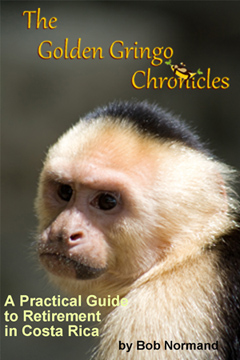 The story of the Golden Gringo Chronicles is also available as a hard copy novel of 192 pages available through Amazon and all major online retailers. ($9.95).
The story of the Golden Gringo Chronicles is also available as a hard copy novel of 192 pages available through Amazon and all major online retailers. ($9.95).
Amazon link: GGC, the Book. (Kindle Edition available)
Follow GG through the first six years of his odyssey in making the decision to retire in Costa Rica, overcoming the trials and tribulations of moving and obtaining residency there and the fun and experience of actually living in Ticoland.
Ride along with the Golden Gringo as he learns about the rich, varied culture of Costa Rica, the incredible bio diversity, the charming nature of the Costa Rican people and the ease with which a sometimes clueless ex-pat can assimilate into a small southwestern town on the Pacific coast.
Whether you are already a Costa Rican resident, someone contemplating a move here or just a traveler who enjoys different cultures, you will find the Golden Gringo Chronicles interesting, entertaining and informative about Costa Rica.
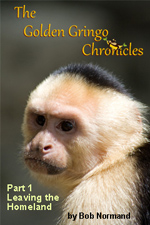 |
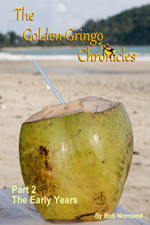 |
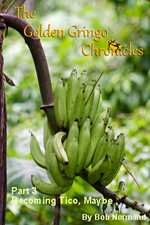 |
A narrative version of the Golden Gringo Chronicles is now also available as a trilogy of E-books in formats compatible with virtually all electronic platforms.
Part 1: (FREE!)
Leaving the Homeland
Click on Part Number above for E-book sample downloads or click the price above right for purchase.
(The best price is on Part 1; it's FREE)
The Golden Gringo Chronicles is a free newsletter that is non-political, non-commercial and, hopefully, entertaining. By signing up you will receive an email each month around the first of the month giving you the links to the latest edition as well as to each individual feature and departmental section.
CLICK HERE TO SIGN-UP FOR THE
GOLDEN GRINGO CHRONICLES
or Email me at gg@goldengringo.com, and see our Website at: www.goldengringo.com

Bob Normand, Editor & The Golden Gringo
Pura Vida!
To Contact GGC World Headquarters (yuk, yuk) to make comments, suggest topics or criticize my bad jokes, just send an email to: gg@goldengringo.com.
Be pithy but kind; I'm sensitive.